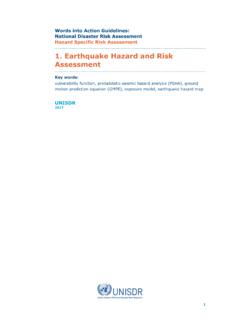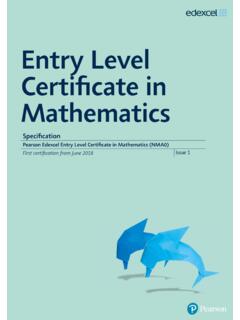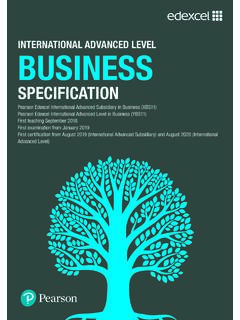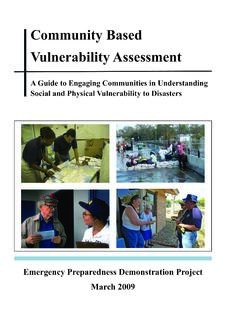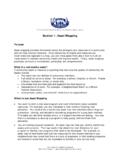Transcription of Assessment for Transition Planning and Preparation: Part One
1 OSSE Division of Specialized Education Secondary Transition Webinar Series Assessment for Transition Planning and Preparation: Part One Presented by Jessica Mattis Objectives the mantra of all Assessment processes Transition Assessment the purposes (goals) of Transition Assessment the domains of Transition Assessment how to assess for Transition Planning using multiple sources of Assessment your role within the Transition Assessment process the essential framework for Transition Assessment (I + E = C) Guiding Questions is Transition Assessment ? can we collect Assessment data? are my potential roles in Transition Assessment ? is the essential conceptual framework for Transition Assessment ? Assessment Development Guiding Question 1 What is Transition Assessment ? Assessment A process of gathering relevant information to plan, evaluate, and make decisions (academic, Transition , career, vocational, social).
2 It is on-going NEVER STOPS It produces GROWTH and DEVELOPMENT Assessment Mantra: Essential Questions Whose needs are being met? What did the student, you, and the team learn from the Assessment process? Where did you record the information? What do we do next? Are our next steps understood by everyone? This is Our Mantra, our Chorus Assessment test Assessment = gathering information Assessment can be formal, informal or a combination of both. Types of Assessment Transition Assessment CAREER Assessment VOCATIONAL Assessment & EVALUATION EDUCATIONAL Assessment Why do we assess? Without Assessment we cannot plan, set goals, or achieve them Assessment drives Transition ! Purposes of Transition Assessment Collect information to Make Transition decisions Establish a baseline of information for instruction and student development Develop Transition Planning goals and objectives Build a process of meeting Transition needs Identify student preferences Describe student interests Define student strengths and abilities Create, track and maintain meaningful Transition plans that will extend beyond secondary education Transition Assessment Transition Assessment is an ongoing process of collecting information on the student s strengths, needs, preferences, and interests as they relate to the demands of current and future living, learning and working environments.
3 All stakeholders participate in the process of information gathering and decision-making. 2007 Corwin Press. Assess for Success: A Practitioner s Handbook on Transition Assessment , 2nd ed., by Stillington, Neubert, Begun, Lombard, and Leconte Guiding Question 2 How can we collect Assessment data? Domains/Content of Transition Assessment & Adulthood Home and Family Physical and Emotional Health Cronin, M. E. & Patton, J. R. (1993). Life skills instruction for all students with special needs: A practical guide for integrating real-life content into the curriculum. p 13. Austin TX: PRO-ED. Self Determination Assessing within Domains Digging deeper and dissecting the domains to identify hidden aspects of the domains to assess more deeply and meaningfully Support Network Activity Review: What is Transition Assessment ? First and foremost it is an Participating in a meaningful Assessment process Causes change Motivates Spurs new Planning or alters plans Advances one s level of career development and knowledge of the post-secondary world Results in learning within all domains How to plan for Transition Assessment Collaborate with all team members* include the student and family in all decisions.
4 Plan a sequence of Assessment activities with target dates throughout each year or refine what you do currently Begin the sequence in middle school and continue through exit from secondary education *Include contingency plans: if someone leaves the team, be sure to replace him or her How to plan for Transition Assessment Obtain or develop protocols and procedures needed for Transition Assessment and Planning Be creative when assessing (gathering information to make decisions) Contact other Transition educators ask them to share what they do Initiate new Transition Assessment activities or processes ( , community mapping , scavenger hunts on O*NET, administering support networks) Assessment is an organized, routine, and ongoing process Types of assessments that inform instruction, career Planning , and Transition Curriculum-based assessments Classroom comprehension checks, essays, checklists Ecological Assessment Functional behavioral Assessment Person-centered and/or futures Planning Community mapping Creating questions for America s Career Info Network Videos Information from employers ( , interviews, tours of businesses, job shadowing) Situational assessments Information from student and family members Student survey or interview Parent survey/interview Observations (Home/School/Community) Recorded observations and interview results Value Assessments and Results Use and create a variety of Assessment /learning opportunities Use the results and findings in IEPs-- Transition Planning Use portfolios (e-portfolios)
5 As a vehicle for collecting and synthesizing Assessment information; students help create and maintain these Use results in Summaries of Performance and in Individual Plans for Employment (you can support the VR Counselor or DDA Case Manager with this), etc. Your Transition Assessment Baseline Process for identifying and learning from your current Transition Assessment practices Tasks: the process of Transition Assessment you currently implement. any gaps in your process and sequence. your process and sequence with a colleague at your school or an educational professional from another school a new idea to your current process and discuss it with your colleague. short and long terms goals for changing the process to meet your students Transition Assessment needs Guiding Question 3 What are my possible roles in Transition Assessment ? Possible Roles Assessor collect information Documenter write down what you and others collect Interpreter describe what information means Translator share Assessment information with others in a language they can understand and convert it into goals and objectives 1.
6 What Assessment information can you provide? 2. When would you provide the information? 3. How can you create an environment where youth feel able to express their goals, dreams, and fears? 4. How will you use the information for Transition Planning and action? 5. What will you do with the information ( where will you record it, with whom will you share it)? 6. When will you update the information? Youth Family member Special educator Employer General Educator Community member Agency representative Multiple Sources of Information Assessment for All Students on the data will follow questions and answers skeptical of easy look for the Assessment literate informed judgment (meaning you need to know the student and the contexts, such as work, post-secondary education, living requirements) beyond test scores they are a small, less authentic part of one s data Partially adapted from M.
7 Scherer (2008) Guiding Question 4 What is the essential conceptual framework for Transition Assessment ? Essential Framework for Assessment Assess all characteristics of the Individual (student) that you can. Assess as many attributes of the student s Ecology ( , environment) as you can. Compare (do a discrepancy analysis of) the student s individual characteristics and his ecological attributes to determine matches and congruence. Framework for Transition , Career & Vocational Assessment Individual + Ecology = Congruence Examples of an Individual s Attributes Interests Level of Career Development Temperaments Behaviors Preferences (ways of learning/Learning styles preferences, etc.) Needs Strengths and Resilience Attitudes Aptitudes and Skills Values and Satisfiers Can Do s /Different Intelligences Self-Efficacy, Esteem, Concept Self-Determination Examples of Ecological Attributes Past, Present and Future Environments Circumstances Relationships Situations Resources (support networks, assistive technology needs, financial, governmental, etc.)
8 Potential barriers and challenges in different settings. Ecological Assessment Finances and means for living (financial literacy) Places to live; living situations Post-secondary settings (colleges, training) Scholarships, loans, etc. Transportation Social support networks Advocate(s) & touchstone Employment Healthcare Self-determination in community environments Civic participation Potential barriers and challenges Ask what and why before asking how to Avoid Planning around instruments we have available or those which require minimal preparation Plan around what the person needs, attributes person possesses, and ecologies they inhabit and seek and the congruence between these This leads to comprehensive, holistic profiles from which you and the student can take meaningful action steps Translating Assessment information into Planning , plans and action Identify strengths, needs.
9 Preferences and interests Develop recommendations for future action by various stakeholders and for each recommendation provide rationale or evidence Share these with the team Convert the recommendations into IEP objectives Converting Findings Into Goals/Objectives Findings: to succeed in truck driving school she needs to operate a GPS, read maps, and figure cargo weights, and figure miles per gallon Goals/Objectives: the student will use two types of GPS devices, will add, subtract, multiply and divide pounds per truckloads, and calculate miles per gallon for trips of various lengths Beginning to Create a Systemic Change for Assessment of All Students Ask specific questions several times a year and include everyone: Do we have plans for it? What are they? How often will we assess? What do we assess? How will we assess? What will the students experience? Who is responsible and for what aspects of the process?
10 Is it customized for the individual student? Do we have checkpoints and benchmarks for the on-going process? Are we doing whatever it takes to assess? Is the process accessible to all? Wrap Up How will I implement my role and responsibilities in Assessment for Transition Planning ? You got to be careful if you don t know where you re going, because you might not get there. -Yogi Berra










